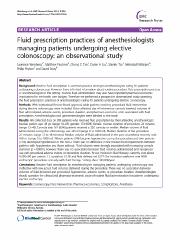Please use this identifier to cite or link to this item:
https://ahro.austin.org.au/austinjspui/handle/1/12254| Title: | Fluid prescription practices of anesthesiologists managing patients undergoing elective colonoscopy: an observational study. | Austin Authors: | Weinberg, Laurence ;Faulkner, Matthew;Tan, Chong O ;Liu, Daniel H;Tay, Stanley;Nikfarjam, Mehrdad ;Peyton, Philip J ;Story, David A | Affiliation: | Anesthesiologist, Department of Anesthesiology, Austin Hospital, Melbourne, Victoria, Australia | Issue Date: | 10-Jun-2014 | Publication information: | Bmc Research Notes 2014; 7(): 356 | Abstract: | Routine fluid prescription is common practice amongst anesthesiologists caring for patients undergoing colonoscopy. However there is limited information about routine procedural fluid prescription practices of anesthesiologists in this setting. Routine fluid administration may also have important pharmaco-economic implications for the health care budget. Therefore we performed a prospective observational study assessing the fluid prescription practices of anesthesiologists caring for patients undergoing elective colonoscopy.With Institutional Review Board approval, adult patients receiving procedural fluid intervention during elective colonoscopy were included.size of intravenous cannula inserted, volumes of fluid administered, adverse events, procedure duration, and pharmaco-economic costs associated with fluid prescription. Anesthesiologists and gastroenterologists were blinded to the study.We collected data on 289 patients who received fluid prescription by their attending anesthesiologist. Median patient age: 48 yrs (range 18-83), gender: 174 (60%) female; median duration of procedure: 24 minutes (range 12-48). Cannula size: 181 (63%) patients received a 22G cannula or smaller. Median volume of fluid administered during the colonoscopy was 325 ml (range 0 to 1000 ml). Median duration of the procedure: 25 minutes (range 12 to 48 minutes). Median volume of fluid administered in the post anaesthesia recovery unit: 450 ml (range 0 to 1000 ml). Fifteen patients (5%) became hypotensive during the procedure and two patients (<1%) developed hypotension in the PACU. There was no difference in the median fluid requirements between patients with hypotension and those without. Fluid volumes were strongly associated with increasing cannula diameter (p = 0.0001), however there was no association between fluid volumes administered and vasopressor use, peri-procedural adverse events, or procedure duration. At our institution fluid therapy currently cost about AUD$4.90 per patient: 1 L crystalloid $1.18 and fluid delivery set $3.77 Our institution performs over 9000 endoscopic procedures annually with fluid therapy costing about $45,000/year.Routine fluid prescription by anesthesiologists managing patients undergoing colonoscopy was ineffective with low actual fluid volumes delivered during the procedure. There was no association between volumes of fluid delivered and procedural hypotension, adverse events, or procedure duration. Anesthesiologists should question the clinical and pharmaco-economic value of routine fluid administration for patients undergoing elective endoscopy. | Gov't Doc #: | 24916073 | URI: | https://ahro.austin.org.au/austinjspui/handle/1/12254 | DOI: | 10.1186/1756-0500-7-356 | Journal: | BMC research notes | URL: | https://pubmed.ncbi.nlm.nih.gov/24916073 | Type: | Journal Article | Subjects: | Adolescent Adult Aged Aged, 80 and over Anesthesiology.methods Colonoscopy.methods Elective Surgical Procedures.methods Female Fluid Therapy.economics.methods.statistics & numerical data Gastroenterology.methods Humans Logistic Models Male Middle Aged Multivariate Analysis Physician's Practice Patterns.statistics & numerical data Prospective Studies Single-Blind Method Young Adult |
| Appears in Collections: | Journal articles |
Files in This Item:
| File | Description | Size | Format | |
|---|---|---|---|---|
| 24916073.pdf | 348.79 kB | Adobe PDF |  View/Open |
Page view(s)
42
checked on Feb 20, 2025
Download(s)
100
checked on Feb 20, 2025
Google ScholarTM
Check
Items in AHRO are protected by copyright, with all rights reserved, unless otherwise indicated.
